2019 Idaho Elk, Mule Deer, Whitetail Hunting Forecast
THE FOLLOWING STORY IS BY ROGER PHILLIPS OF THE IDAHO DEPARTMENT OF FISH AND GAME
Idaho deer and elk hunters should see good to excellent hunting for elk and white-tailed deer, and average mule deer hunting in 2019, but that’s likely to vary by location across the state.
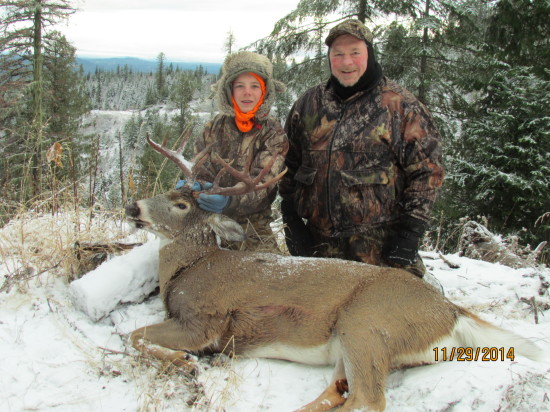
A difficult winter for mule deer fawns took its toll on herds for the second time in three years, which will affect the numbers and age classes of bucks. However, winter had a lesser effect on whitetails in North Idaho and the Clearwater area. White-tailed deer herds there have remained strong and resilient in recent years based on hunter harvest.
Elk typically do not succumb to winter kill except under extreme conditions, and elk herds continue to do well in most areas of the state and are on track to match some historic-high harvests.
ELK
Idaho elk hunters have recently enjoyed excellent hunting with 22,325 elk taken in 2018, which ranks among the top-10, all-time harvests (ninth).
“Elk hunting is good, and it’s been good for a number of years, and I don’t think that’s going to change,” Fish and Game’s Deer/Elk Coordinator Daryl Meints said.
Fish and Game is currently meeting or exceeding its elk population goals in 17 of 22 elk zones, he said.
The statewide elk harvest has exceeded 20,000 annually for the last five years, which has not happened since the all-time high harvests between 1988-96. There’s no indication that the 2019 harvest won’t be similar to 2018 and continue that trend.

During 2018-19 winter, Fish and Game managers monitored 868 radio collared elk in 21 areas of the state. Adult cow survival was 98 percent and calf survival was 66 percent. The leading cause of mortality for both adult cow elk and calves was mountain lions.
Meints said part of the reason for the robust herds is wildlife managers often have more control over elk populations than they do over deer because one bad winter can take a significant percentage of the deer population, but elk tend to be hardier and capable of withstanding harsh winters.
Meints also noted that Fish and Game’s 2014 elk plan called for more elk in many areas of the state, which coincided with a long string of mild winters prior to 2016-17 that helped elk herds to expand.
“All the stars perfectly aligned,” he said, adding that elk “are a great pioneer species that have expanded into new areas, and they are doing well.”
Like elk, hunters have adapted and shifted hunting efforts toward “front country” areas where herds are thriving, rather than backcountry and wilderness areas that drew many elk hunters in the past.
“Elk and elk hunters have redistributed themselves across the landscape,” Meints said.
Hunter numbers have correspondingly grown as word has gotten out about Idaho’s elk hunting returning to some of its past glory. Hunter numbers have exceeded 100,000 annually over the last five years. The allotment of nonresident elk tags has already sold out in 2019, and it’s the third-straight year that has occurred.
Aside from healthy herds, part of the draw for elk hunters is Fish and Game’s generous allocation of over-the-counter, general hunt tags, and a broad range of hunting opportunity, particularly for archery hunters.
“Over the last five to 10 years, Idaho has become a destination for archery elk hunting, and I don’t think there’s a better place for it right now,” Meints said.
2018 harvest at a glance
Total elk harvest: 22,325
Overall hunter success rate: 23.5 percent
Antlered: 11,326
Antlerless: 10,999
Taken during general hunts: 13,473 (18.2 percent success rate)
Taken during controlled hunts: 8,853 (42 percent success rate)
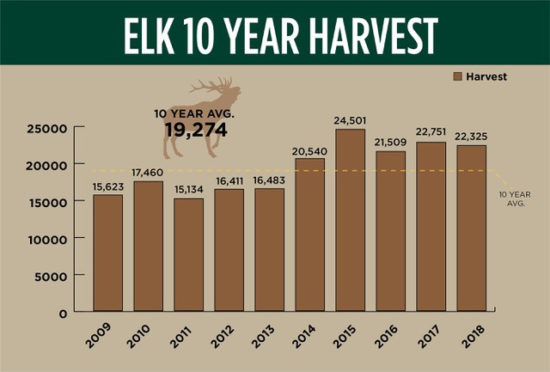
MULE DEER
Forgive the cliche, but Idaho’s mule deer population is currently in a half empty/half full situation. Last year’s harvest was within 5 percent (about a thousand animals) of the 10-year average, and this year’s harvest is likely to be similar.
But prior to 2016, Idaho had five consecutive mild winters, which helped build mule deer throughout the state, mostly in the south and central areas where mule deer dominate. Then the 2016-17 winter hit, which took a large segment of that year’s fawn crop. Fish and Game restricted doe harvest in an attempt to quickly rebuild herds, which was reflected in the 2017 deer harvest being 11,573 fewer deer than in the 2016 harvest.
The harvest saw a slight bump in 2018, up about 1,500 mule deer, and this fall’s mule deer harvest is likely to be similar to last year, or a little smaller.
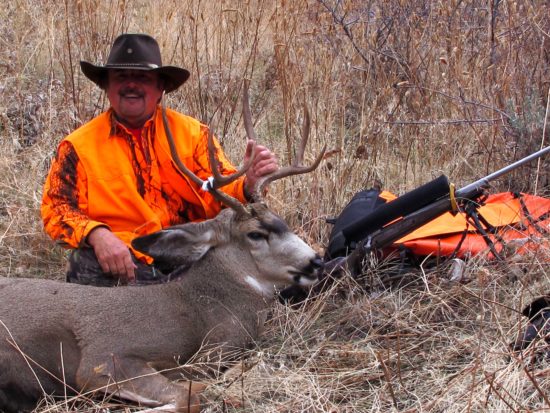
Deep snowfall in early 2019 followed by a prolonged wet and cool spring caused winter fawn survival to take a substantial dip for the second time in three years.
“That record snow pack that we observed in February did not do the fawns any favors,” said Meints. “It was not like the winter of 2016-17, but we were below the long-term average for fawn survival.”
About 46 percent of radio collared fawns survived last winter, which is below the 20-year average of 58-percent survival, but still above the 30-percent survival in the 2016-17 winter.
Fawn survival is significant because yearling, or two-point bucks (which were born last year), typically make up a significant portion of the buck harvest. Many of the fawns that died last winter would have been two-point bucks this fall.
However, there are still older bucks remaining in the herds, and considering mule deer have faced two of the worst winters in recent memory over the past three years, harvest will still likely be close to the 10-year average, or slightly below it, for 2019.
Wildlife managers saw normal winter survival of radio collared mule deer does, which typically exceeds 90 percent, so if winter weather returns to average, there could be a modest increase in the herds next year.
It should also be noted that fawn survival was not consistent throughout the state, so some areas were closer to average, while others were below. The number of animals available for hunters and hunter success will vary significantly throughout mule deer country.
2018 harvest at a glance
Total mule deer harvest: 26,977
Overall hunter success rate: 31.1 percent
Antlered: 21,471
Antlerless: 5,506
Taken during general hunts: 20,060 (27.1 percent success rate)
Taken during controlled hunts: 6,917 (55.3 percent success rate)
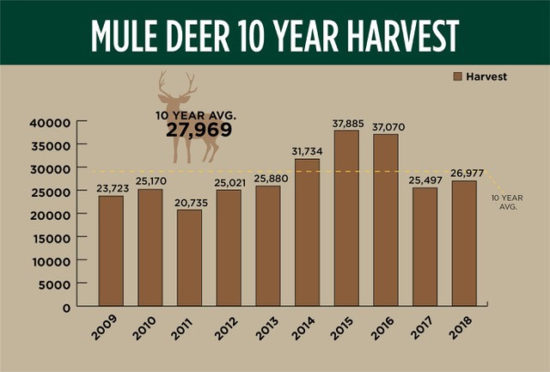
WHITE-TAILED DEER
All signs point to another good year for whitetail hunters with lots of opportunity and the chance to get a bigger buck for those who put in the time and effort.
The past five years have been the most productive in Idaho’s history in terms of white-tailed deer harvest, which has been above 25,000 annually during that span.
Hunters harvested 25,134 whitetails in 2018, which ranks fifth-best all-time. Success rates, the number of 5-point deer harvested, and hunter numbers in 2018 also remained fairly consistent with recent years. With abundant whitetail herds and lots of general season, either-sex hunting opportunity, it looks like the trend will continue into 2019.
“Over the last few years we’ve been staying really steady on hunter numbers and hunter success and percent 5-point bucks in the harvest,” Meints said. “Given that, one would surmise that whitetail populations are doing quite well.”
Historically, the vast majority of the whitetail harvest has occurred in the Panhandle and Clearwater regions. It was no different in 2018, as the white-tailed deer harvest in these regions accounted for 94 percent of the statewide total.
Northern Idaho’s whitetail herds appear to be in good shape after the winter, which was late to arrive in Northern Idaho. Snowfall was well below average until mid-February, when winter arrived with a vengeance — breaking longstanding records in places like Lewiston and on the Palouse. Despite the late, heavy snow, this winter doesn’t appear to have taken a heavy toll on whitetail herds.
“We observed some mortality, but it was not excessive,” according to Regional Wildlife Manager Clay Hickey. “We tended to see it in places where we had lots of deer, which might not have been in as good of shape going into the winter because of high deer densities. Even then, mortality was spotty.”
In the past, Fish and Game has not radio collared whitetail fawns and does each winter to monitor their survival, nor have they done annual population surveys for whitetails. Biologists have instead relied on other data to determine trends in the population, including harvest data.
This is changing under the new White-Tailed Deer Management Plan for 2020-25. This winter, Fish and Game researchers started a robust, long-term research plan for the species, which will ultimately bring population monitoring for whitetails up to the same level as mule deer.
“This was the first year – the pilot study, if you will,” Meints said. “But this will be ongoing for years, and expanding across Northern Idaho.”
For now, wildlife managers use the historical metrics to evaluate the white-tailed deer population, and whitetail hunting is meeting nearly all of the department’s objectives for the number of hunters, hunter days, buck harvest, and percentage of five point bucks in the harvest.
Idaho has not seen any widespread outbreaks of whitetail diseases since 2003, and no outbreaks have been detected this year. But with parts of Northern Idaho experiencing dry conditions during summer, Meints said there needs to be continued monitoring for epizootic hemorrhagic disease (EHD), a virus that is spread in whitetail populations via bites from gnats or midges. When water sources dry up and deer are concentrated on those that remain, the potential for a large-scale outbreak is greater.
“This virus is out there and present all the time, and you lose some deer to it every year,” Meints said. “But under the right environmental conditions, it can lead to some substantial losses in a short amount of time.”
2018 harvest at a glance
Total white-tailed deer: 25,134
Overall hunter success rate: 41.5 percent
Antlered: 15,163
Antlerless: 9,969
Taken during general hunts: 21,975 (40.2 percent success rate)
Taken during controlled hunts: 3,158 (53.8 percent success rate)
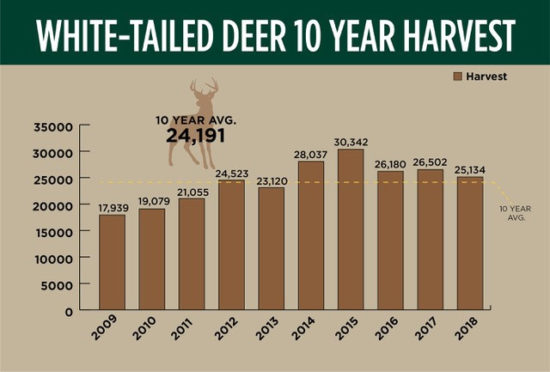
Here are regional outlooks compiled by regional wildlife managers and communications managers in each Fish and Game region.
PANHANDLE REGION
This year should be productive for deer and elk in the Panhandle, however, many factors can impact hunter success. Weather conditions during the hunting season affect big game behavior and distribution. Hot, dry weather can result in game using green agriculture fields or thick, timbered areas. Rain can improve availability of quality, native forage, which can lead to big game being more widely dispersed on the landscape.
The winter of 2018-19 started relatively mild in most parts of the region until February, when some areas of the Panhandle received record monthly snowfall. Elk calf survival from six months to a year was around 60 percent in Unit 6. During mild winters, calf survival was about 80 percent compared to the most recent hard winters when survival was about 45 percent.
Due to lower calf survival after the winters of 2017 and 2018, there may be fewer raghorn bulls in some areas this year. Cow survival has remained relatively high (94 percent) regardless of winter conditions, and mature bulls should be roaming the woods this fall.
Mule deer hunters intending on hunting Unit 1 should beware of a season change in that unit. Mule deer buck harvest on the “Regular Tag – General Any Weapon” season now ends on Nov. 20. Elk hunters in the Panhandle should also review the current big game rules because some controlled hunt area boundaries have changed.
Scouting potential hunting areas may give hunters an idea of animal distribution and behavior. Hunters can also use preseason scouting to check road and trail accessibility and conditions, as well as make landowner contacts if they are planning to hunt on or near private property.
CLEARWATER REGION
Early winter conditions in the Clearwater were exceptionally mild. However, winter arrived with a vengeance in February, with record-setting snowfall that month. Probably due to the late onset of the severe conditions, no significant winter mortality was detected on the regions’ big game herds. Some spotty white-tailed deer mortality was observed, but it did not appear to be widespread or likely to cause detectable declines at the population level.
Spring and early summer conditions were substantially cooler and wetter than normal. These conditions have resulted in very good summer habitat conditions for regional big game herds.
The region possesses healthy white-tailed deer populations, and therefore, abundant hunting opportunity with high success rates and a high percentage of bucks harvested being larger than 4 and 5-points. The most productive whitetail units in the region tend to be those units either at the agriculture/timber interface, or units with substantial timber harvest and a variety of habitats (Units 8, 8A, 10A, 11, and 11A).
Although whitetail populations appear to be strong across the region and all management criteria are being met, social concerns have resulted in some reductions in whitetail hunting opportunities. Unit 10A will again close earlier than surrounding units, and extra antlerless hunting opportunities will be reduced in many hunts across the region.
Mule deer
The most robust mule deer populations in the region are located along the Snake and Salmon River breaks (units 11, 13, 14, and 18). These units are limited to controlled hunts. Some mule deer occur in the other units across the region, albeit at relatively low densities. However, those hunters willing to put forth the effort to get into some of the regions’ backcountry areas (Units 16A, 17, 19, and 20) can find good numbers of mule deer during general seasons.
Elk
Elk numbers continue to lag in the Lolo and Selway Zones, although some positive signs in calf recruitment levels have been observed in recent years. Populations have also declined in portions of the Elk City and Hells Canyon Zones, resulting in a reduction of hunting opportunities in these zones. Populations appear to be relatively stable in the Dworshak and Palouse Zones.
SOUTHWEST REGION
Winter survival of mule deer fawns in Unit 39 was slightly lower than the long-term average, but the number of yearling bucks will be similar to last year. Overall deer numbers have been increasing in Unit 39 for the last several years. When surveyed in January 2018, wintering deer in Unit 39 were up about 5,000 animals from the 2010 count. Adult winter survival has been consistently high. The antlerless youth season in Unit 39 runs to Oct. 31 in 2019 and coincides with the regular season.
Winter fawn survival in Units 33, 34 and 35 was average. Mule deer are widely scattered in these units, with only about 4,500 animals wintering along the South Fork of the Payette River. There is no youth antlerless season for mule deer in these units. However, youth are allowed to harvest antlerless white-tailed deer.
Elk
Elk calf survival in the Sawtooth Zone was above the long-term average. Cow survival has been consistently high the past five years, which has allowed this herd to continue to grow. As a result of positive growth, the Fish and Game Commission approved an increase in the number of tags available on both the A (434 additional tags) and B (274 additional tags) tags. Those tags are sold out for 2019.
The Boise River Zone has seen consistently high winter calf and cow survival rates during the past five years. The population has remained stable due to antlerless harvest opportunity. Elk are moving back into the areas burned during the 2016 Pioneer Fire.
McCALL REGION
Winter survival for mule deer fawns in Weiser and McCall areas was slightly lower than the long-term average, which will result in fewer yearling bucks available to hunters this year. Adult survival was better, so the number of mature bucks in these units should be similar to last year.
A few changes were made to mule deer seasons in Units 31, 32 and 32A: youth hunting on a regular deer tag may harvest antlered or antlerless animals from Oct. 10–16, but may only harvest antlered deer during the remainder of the season (Oct 17-24).
Elk
Last winter, biologists completed helicopter surveys for elk in the Weiser and Brownlee Zones. Data indicated that the elk populations in both zones are above Fish and Game’s objectives. In the Brownlee Zone, bull elk numbers have increased substantially, and are far above the department’s objectives. In the Weiser Zone, elk numbers have declined since the previous survey due to additional hunting opportunity, but are still above objectives.
These surveys resulted in changes to hunting seasons. In Brownlee, controlled hunt tags were added for both bull and cow elk. In Weiser, the A-tag antlerless season was shortened by one week. During the B-tag antlerless season, hunters no longer have to remain within one mile of private cultivated fields in Units 22 and 32A. Several shoulder seasons (late summer and winter hunts) were shortened.
Elk numbers are within objectives in the McCall Zone. There were no surveys or significant changes to regulations in this zone for 2019.
MAGIC VALLEY REGION
Mule deer populations appear to be holding steady in the region. Last winter had a slight decrease in fawn survival, which may mean hunters will see fewer yearling bucks this fall.
Due to a wet spring, habitat conditions have been excellent for both forage and available water. Hunters will be pleased to know that with these improved conditions antler growth will be excellent, and hunters can expect to see some large bucks for harvest this year.
With abundant moisture and feed, animals will be widely dispersed across the landscape and not concentrated around water or good feed. Plan the hunts accordingly because historic hunting spots may not have the same amount of game in it this year, so be flexible, mobile and adapt to the conditions.
Elk
Elk numbers remain strong and are expanding in all elk zones, which puts them at, or above, harvest and population management objectives. Overwinter calf survival continues to be strong.
Due to the healthy numbers of elk, more over-the-counter elk hunting opportunities were provided this year, especially for antlerless elk.
Like mule deer, habitat conditions for elk have been excellent for both forage and available water. Abundant elk herds will benefit from these improved conditions, resulting in excellent antler growth, and hunters should see (and hopefully harvest) some large bulls this year. As with deer, hunters should anticipate that elk may be more dispersed, meaning that hunters may need to venture away from their “traditional” hunting locations.
Regional biologists routinely hear questions about how well animals such as elk survive during our harsh winter conditions. While Southern Idaho winters can be harsh, concerns over hard winters and lots of winter mortality are generally unfounded. The vast majority of animals migrate out of their summer range, leaving the high country where snow accumulates, such as in the Wood River Valley, to winter in lower elevations like the Bennett Hills, where the winter snow is not as deep.
SOUTHEAST REGION
The winters from 2012 through 2016 were relatively mild in Southeastern Idaho, which was good news for big game populations and hunters alike. Elk and mule deer numbers were increasing and hunters were reporting some of the best success rates the area had seen in a while.
The winter of 2016-17 was extremely severe, and big game populations experienced higher than normal mortality. In particular, mule deer populations are negatively impacted, especially fawns and older deer. Additionally, doe mule deer that survive such harsh winters are typically in poor body condition, which results in lower reproductive rates and survival of fawns the subsequent year.
The winter of 2017-18 was milder, offering some reprieve. However, the effects of the previous harsh winter were evident during December herd composition surveys as the number of fawns per 100 does in the most affected population had dropped from nearly 80:100 during December 2017 to just over 50:100 in December 2018. Hunter success increased slightly in the fall of 2018 compared to the significant decline in hunter success the year prior to that severe winter. The 2018-19 winter was again severe and extended late into the spring, likely resulting in higher fawn mortality.
Here is what that could mean to hunters:
Deer in Southeast Idaho have not rebounded from the extremely severe 2016-17 winter, and population models suggest that the overall population has not grown since that time. However, even if a population is stable, the number of bucks available to harvest changes each year, and it is dependent on winter fawn survival.
For example, in 2015, when winter fawn survival was very high, 47 percent of antlered deer at check stations were yearlings, but in 2017 (after a severe winter) only 16 percent were yearlings. In summary, success rates in 2017 were quite low partially because winter fawn survival was so low.
Success rates then increased in 2018 because winter fawn survival had been higher during the 2017-18 winter (resulting in more yearling bucks), not because there were more deer in the herds.
Biologists expect overall harvest this fall to be similar to 2018, or slightly below. This would be the result of average, or slightly below-average, winter fawn survival. Fish and Game biologists expect the proportion of adult bucks (at least two years old) in the harvest this fall to increase, and the proportion of yearling bucks harvested to decrease compared with the 2018 hunting season. This information highlights the large annual variations in mule deer populations depending on environmental conditions.
Elk
Elk are more resilient to harsh winter conditions than deer, and consequently, they are doing well across the region as evidenced by aerial surveys conducted the past few years. Hunters should expect good elk hunting this fall.
UPPER SNAKE REGION
Deer and elk on the westside of the region fared better than those on the east side. This is largely due to harsh winter conditions of crusty and deep snow accumulating across much of the eastern part of the state.
Mule Deer
Mule deer hunters in the Upper Snake will likely see fewer two points because the winter survival for fawns was low. Mule deer fawn survival studies for the 2018-19 winter showed a 50 to 60 percent mortality in those populations that were directly monitored in the Upper Snake.
Unit 59A = 59 percent mule deer fawn mortality
Unit 50 = 50 percent mule deer fawn mortality
Unit 67 = 60 percent mule deer fawn Mortality
“Teton Canyon and Island Park likely had higher mortality rates than this based on winter severity and adult doe mortality,” said Curtis Hendricks, Wildlife Manager in the Upper Snake. “I would bet that fawn mortality in these areas was over 70 percent, and the Tex Creek population was likely similar to the Palisades population at around 60 percent.”
Adult doe mortality reached 15 percent in some areas of the Upper Snake, causing concern for wildlife managers.
“Adult doe mortality for Teton and Island Park is a bit high and something we will pay close attention to,” Hendricks said. “Our adjustments to mule deer hunting opportunity were likely well founded by the information.”
The following regulation changes were made to the 2019-20 seasons to reduce pressure on antlerless deer harvest and bolster mule deer populations in the Upper Snake:
50 percent reduction in all either-sex hunts except units 66 and 69 where all either sex hunts are eliminated.
Youth Antlerless harvest is restricted to one week (Oct. 10 to 16) in all general hunt units (50, 51, 58, 59, 59A, 60, 60A, 61, 62, 62A, 63, 64, 65, and 67), except units 66 and 69 where all youth antlerless harvest is eliminated.
Elk
Elk hunters will be happy to hear that despite the harsh winter conditions and predation, elk herds in the Upper Snake did well last winter. All of the region’s elk zones are at or above objective for bulls and cows, so hunters should expect to see a good number of elk similar to the abundance of recent years.
Salmon Region
Stable to increasing mule deer populations across the Salmon Region from 2012 through 2016 were due to favorable year-round weather conditions. Populations decreased significantly in 2017 following an extended period of deep snow and cold weather during the 2016-17 winter. Poor condition does coming out of the 2016-17 winter then produced a well-below average of 49 fawns per 100 does. A return to normal summer, fall, and winter conditions in 2018 and 2019 have improved deer production in the region. However, marginal spring weather conditions in 2018 and 2019 have produced below average fawn spring survival rates of 50 and 37 percent, respectively. Hunters will likely see no significant change in the number of bucks in the region from last year.
Elk populations continue to do well in the Salmon Region, and elk hunting will be good this year. Elk Zones east of U.S. 93 (Beaverhead, Lemhi, and Pioneer) are at or above elk plan objectives, and additional general season A and B-tag antlerless elk, and antlered elk control permit opportunities are available this fall. Elk Zones west of U.S. 93 (Salmon, Middle Fork) are at, or slightly below, objectives, and hunting success will be similar to last year.
Get a Free NewsLetter Here
[hubspot type=form portal=5325588 id=614ee0f1-9297-4340-b0f4-5b40dfd45220]

